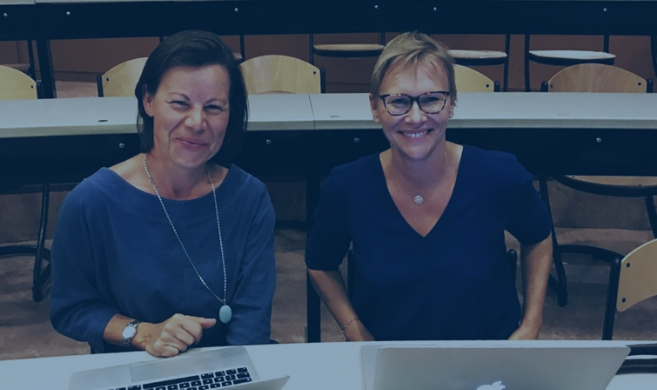listen to the BREAKTHROUGH podcast:
watch the filmed podcast:
What motivated you both to write this book back in 2014?
Hélène Musikas: I don’t think there's a single company today that wouldn't claim that its strategy must be more innovative. Yet very few are happy with what it does around innovation. So, this book aims to help them think through innovation, and in particular, one kind of innovation that we call business model innovation.
Laurence Lehman-Ortega: The book, in my opinion, is both about innovation and, more generally speaking, strategy. As professors, we believed that we had the tools to explain the industry and analyze the market for our students. But, searching for any literature on the subject, we discovered this blank page from which we had to somehow elaborate new strategic options. There was nothing really to guide us, and there were very limited tools to help both our students and practitioners come up with innovative strategies. We decided to work on this business model innovation to provide them with clues on how to actually come up with an innovative strategy.
Could you describe the three pillars of the business model on which the book lies?
LLO: Sure. We have the value proposition on one side, which is the description of what I'm offering to my customers. That's the first pillar. The second is what we call the value architecture which is basically the extended value chain. If the first pillar answers the question: “Who” and “What?”, the second pillar answers the question “How?” How have I organized myself to deliver this product or service to my customers?
Then we have the third pillar, which we've called the contribution. Contributions are, of course, the financial contribution and the profit equation. But also the environmental and social contribution. How a company manages to work within those three pillars explains its performance. And that contributes to the overall purpose of the company.
It seems there’s a need to balance or align value proposition and value architecture in order to create performance. Is that right?
HM: Absolutely. I see it as a unique combination. Successful companies are able to design this unique combination of the value proposition and the value architecture to generate great performance. With companies that are less successful in their strategy, this combination is less consistent; it doesn't click together well, and therefore, the performance suffers. In our book, we’ve designed illustrations that depict the interaction between these elements, and I think this is a really important thing to understand.
We've talked about the three pillars. What about these 14 directions that you explore to invent or reinvent one's business? Middle you say? You write that it’s to answer the needs of the present without compromising the needs of future generations, which is quite poetic. Without listing these 14 directions for you, what are the most important ones?
LLO: Well, in a very structured way, it's an invitation to brainstorm.
HM: Yes, we’re inviting managers to sit around the table, brainstorm with their colleagues, and share many ideas. Those 14 directions provide some structure and guidance for brainstorming.
LLO: We wanted to offer companies some creativity. So, each of the 14 directions is illustrated by one or several examples to inspire people.
The first edition of this 234-page manual came out in 2014. How does the third edition, fresh off the press, compare?
HM: In this 2023 version, we’ve revisited our entire process through the filter of the doughnut economy, as imagined by economist Kate Raworth. We're looking at the business model's environmental and societal performances, not only its financial success.
The other part that was revised, of course, is the fourth chapter where we dissect the 50 examples of companies we find inspirational. because we wanted to propose newer firms. We wanted to talk about companies that have fully embarked in those business models of the future. So, this one was also revisited significantly.
LLO: We can say that the overall structure hasn't changed per se. We still have four chapters: one about the business model, one about the 14 directions, and one about how to make innovation happen in organizations. The final chapter details the 50 cases we find exemplary. Of course, the content of chapter one has changed extensively, and also after 50 cases.
HM: Another principle we've kept, which I think explains the popularity of the book, is its practicality. So, we devote a double page to each case study. Therefore, they are standalone, and you learn something just by reading that double page. You can then close it and open another double page. This way of structuring the book allows it to be very easily read.
But it doesn’t simply boil down to innovation alone, does it?
HM: No, not at all. Just telling people they need to be innovative isn't enough. You really must encourage a specific culture where people are free to think differently and to experiment. Innovation, especially business model innovation doesn’t work overnight. You will always have some time when you are trying to play around with the business model, understand how it could work, and test the hypothesis. And this is all about experimentation, which is a very important phase in innovation. And if you don't accept to fail then you don't innovate because you don't want to lose, so you don't try. This is the cultural part, a very important component of this change.
LLO: It's actually a combination of things that cumulatively limit people's freedom, not only to bring about ideas but to test them and to improve them. I think making innovation happen is really about a mindset and a context that you create more than the processes themselves.
HM: What we really like is this idea that when you innovate, you need to both exploit your existing business model and explore the business model of tomorrow. So, you have this exploitation-exploration dilemma. Some people are really good with incremental innovation and fine-tuning the existing business model.
Another vital factor is your team. You need people inside the organization who think about tomorrow's business model because, again, it won't appear overnight. And to test it, to experiment with it. It's not going to work right away. So, you need to have these two types of people, or at least there are two parts of the organization working on expectation and exploration. I think, more generally, innovation is really about collective intelligence.
LLC: And bringing people together from different horizons, people who think differently. Because innovation is also a lot about challenging convention. For example, when companies decide to apply this Odyssey 3.14 approach, we always recommend that they be very careful about the way they create the team to brainstorm. Basically, diversity is key. We don't want only marketeers or only client representatives on the team.









